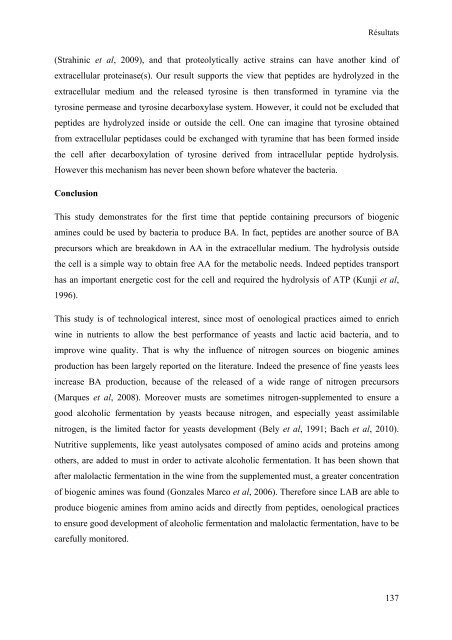THESE Maryse Bonnin Jusserand - Université de Bourgogne
THESE Maryse Bonnin Jusserand - Université de Bourgogne
THESE Maryse Bonnin Jusserand - Université de Bourgogne
You also want an ePaper? Increase the reach of your titles
YUMPU automatically turns print PDFs into web optimized ePapers that Google loves.
Résultats<br />
(Strahinic et al, 2009), and that proteolytically active strains can have another kind of<br />
extracellular proteinase(s). Our result supports the view that pepti<strong>de</strong>s are hydrolyzed in the<br />
extracellular medium and the released tyrosine is then transformed in tyramine via the<br />
tyrosine permease and tyrosine <strong>de</strong>carboxylase system. However, it could not be exclu<strong>de</strong>d that<br />
pepti<strong>de</strong>s are hydrolyzed insi<strong>de</strong> or outsi<strong>de</strong> the cell. One can imagine that tyrosine obtained<br />
from extracellular peptidases could be exchanged with tyramine that has been formed insi<strong>de</strong><br />
the cell after <strong>de</strong>carboxylation of tyrosine <strong>de</strong>rived from intracellular pepti<strong>de</strong> hydrolysis.<br />
However this mechanism has never been shown before whatever the bacteria.<br />
Conclusion<br />
This study <strong>de</strong>monstrates for the first time that pepti<strong>de</strong> containing precursors of biogenic<br />
amines could be used by bacteria to produce BA. In fact, pepti<strong>de</strong>s are another source of BA<br />
precursors which are breakdown in AA in the extracellular medium. The hydrolysis outsi<strong>de</strong><br />
the cell is a simple way to obtain free AA for the metabolic needs. In<strong>de</strong>ed pepti<strong>de</strong>s transport<br />
has an important energetic cost for the cell and required the hydrolysis of ATP (Kunji et al,<br />
1996).<br />
This study is of technological interest, since most of oenological practices aimed to enrich<br />
wine in nutrients to allow the best performance of yeasts and lactic acid bacteria, and to<br />
improve wine quality. That is why the influence of nitrogen sources on biogenic amines<br />
production has been largely reported on the literature. In<strong>de</strong>ed the presence of fine yeasts lees<br />
increase BA production, because of the released of a wi<strong>de</strong> range of nitrogen precursors<br />
(Marques et al, 2008). Moreover musts are sometimes nitrogen-supplemented to ensure a<br />
good alcoholic fermentation by yeasts because nitrogen, and especially yeast assimilable<br />
nitrogen, is the limited factor for yeasts <strong>de</strong>velopment (Bely et al, 1991; Bach et al, 2010).<br />
Nutritive supplements, like yeast autolysates composed of amino acids and proteins among<br />
others, are ad<strong>de</strong>d to must in or<strong>de</strong>r to activate alcoholic fermentation. It has been shown that<br />
after malolactic fermentation in the wine from the supplemented must, a greater concentration<br />
of biogenic amines was found (Gonzales Marco et al, 2006). Therefore since LAB are able to<br />
produce biogenic amines from amino acids and directly from pepti<strong>de</strong>s, oenological practices<br />
to ensure good <strong>de</strong>velopment of alcoholic fermentation and malolactic fermentation, have to be<br />
carefully monitored.<br />
137

















